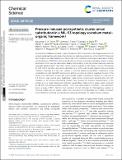Files in this item
Pressure-induced postsynthetic cluster anion substitution in a MIL-53 topology scandium metal-organic framework
Item metadata
| dc.contributor.author | Thom, Alexander J. R. | |
| dc.contributor.author | Turner, Gemma | |
| dc.contributor.author | Davis, Zachary Harry | |
| dc.contributor.author | Ward, Martin | |
| dc.contributor.author | Pakamorė, Ignas | |
| dc.contributor.author | Hobday, Clare | |
| dc.contributor.author | Allan, David | |
| dc.contributor.author | Warren, Mark | |
| dc.contributor.author | Leung, Wai L. W. | |
| dc.contributor.author | Oswald, Iain D. H. | |
| dc.contributor.author | Morris, Russell Edward | |
| dc.contributor.author | Moggach, Stephen | |
| dc.contributor.author | Ashbrook, Sharon E. | |
| dc.contributor.author | Forgan, Ross S | |
| dc.date.accessioned | 2023-07-03T14:30:04Z | |
| dc.date.available | 2023-07-03T14:30:04Z | |
| dc.date.issued | 2023-07-28 | |
| dc.identifier | 288302070 | |
| dc.identifier | 60ef7d09-607b-49d7-a801-988551633be2 | |
| dc.identifier | 85164371266 | |
| dc.identifier.citation | Thom , A J R , Turner , G , Davis , Z H , Ward , M , Pakamorė , I , Hobday , C , Allan , D , Warren , M , Leung , W L W , Oswald , I D H , Morris , R E , Moggach , S , Ashbrook , S E & Forgan , R S 2023 , ' Pressure-induced postsynthetic cluster anion substitution in a MIL-53 topology scandium metal-organic framework ' , Chemical Science , vol. 14 , no. 28 , pp. 7716-7724 . https://doi.org/10.1039/D3SC00904A | en |
| dc.identifier.issn | 2041-6520 | |
| dc.identifier.other | ORCID: /0000-0002-4538-6782/work/138327064 | |
| dc.identifier.other | ORCID: /0000-0001-7809-0315/work/138327207 | |
| dc.identifier.uri | https://hdl.handle.net/10023/27876 | |
| dc.description | Funding: RSF thanks the Royal Society for receipt of a URF, EPSRC (EP/N509668/1), and the University of Glasgow for funding. IDHO and MRW thank EPSRC for funding (EP/N015401/1). We acknowledge Diamond Light Source for time on I19-2 under proposal CY24020. ZHD thanks the ERC (Advanced Grant 787073 ADOR) for studentship funding. CLH thanks UKRI for a Future Leaders Fellowship (MR/V026070/1) and the University of Edinburgh for a Chancellor’s Fellowship. SAM acknowledges the support of the Australian Research Council (ARC) from a Future Fellowship (FT200100243) and Discovery Project (DP 220103690). | en |
| dc.description.abstract | Postsynthetic modification of metal-organic frameworks (MOFs) has proven a hugely powerful tool to tune physical properties and introduce functionality, by exploiting reactive sites on both the MOF linkers and their inorganic secondary building units (SBUs), and so has facilitated a wide range of applications. Studies into the reactivity of MOF SBUs have focussed solely on removal of neutral coordinating solvents, or direct exchange of linkers such as carboxylates, despite the prevalence of ancillary charge-balancing oxide and hydroxide ligands found in many SBUs. Herein, we show that the µ2-OH ligands in the MIL-53 topology Sc MOF, GUF-1, are labile, and can be substituted for µ2-OCH3 units through reaction with pore-bound methanol molecules in a very rare example of pressure-induced postsynthetic modification. Using comprehensive solid-state NMR spectroscopic analysis, we show an order of magnitude increase in this cluster anion substitution process after exposing bulk samples suspended in methanol to a pressure of 0.8 GPa in a large volume press. Additionally, single crystals compressed in diamond anvil cells with methanol as the pressure-transmitting medium have enabled full structural characterisation of the process across a range of pressures, leading to a quantitative single-crystal to single-crystal conversion at 4.98 GPa. This unexpected SBU reactivity – in this case chemisorption of methanol – has implications across a range of MOF chemistry, from activation of small molecules for heterogeneous catalysis to chemical stability, and we expect cluster anion substitution to be developed into a highly convenient novel method for modifying the internal pore surface and chemistry of a range of porous materials. | |
| dc.format.extent | 9 | |
| dc.format.extent | 1023317 | |
| dc.language.iso | eng | |
| dc.relation.ispartof | Chemical Science | en |
| dc.subject | Solid-state NMR spectroscopy | en |
| dc.subject | Metal-organic frameworks | en |
| dc.subject | High-pressure | en |
| dc.subject | Secondary building unit | en |
| dc.subject | Postsynthetic modification | en |
| dc.subject | X-ray crystallography | en |
| dc.subject | DAS | en |
| dc.subject | MCC | en |
| dc.title | Pressure-induced postsynthetic cluster anion substitution in a MIL-53 topology scandium metal-organic framework | en |
| dc.type | Journal article | en |
| dc.contributor.sponsor | European Research Council | en |
| dc.contributor.institution | University of St Andrews. School of Chemistry | en |
| dc.contributor.institution | University of St Andrews. EaSTCHEM | en |
| dc.identifier.doi | 10.1039/D3SC00904A | |
| dc.description.status | Peer reviewed | en |
| dc.identifier.grantnumber | 787073 | en |
This item appears in the following Collection(s)
Items in the St Andrews Research Repository are protected by copyright, with all rights reserved, unless otherwise indicated.

